
Feature Article
Review of Food Poisoning Outbreaks Related to Food Premises and Food Business in 2020
General Situation
In 2020, the Centre for Food Safety (CFS) received 229 referrals of food poisoning outbreaks (FPOs) with 632 persons affected. Following the global COVID-19 pandemic, takeaway foods have become more popular among the public. The number of FPOs attributed to takeaway foods and the number of persons affected increased from 36 cases (19.5% of the total FPOs) and 236 persons in 2019 to 128 cases (55.9%) and 331 persons in 2020. Despite an overall decrease in FPOs since 2012 (see Figure 1), there was a small rebound in 2019 and 2020. The increase last year was mainly due to one large-scale cluster involving 99 epidemiologically linked outbreaks related to sandwiches. While more FPOs were recorded compared with 2019, the number of affected persons hit a record low in 2020.
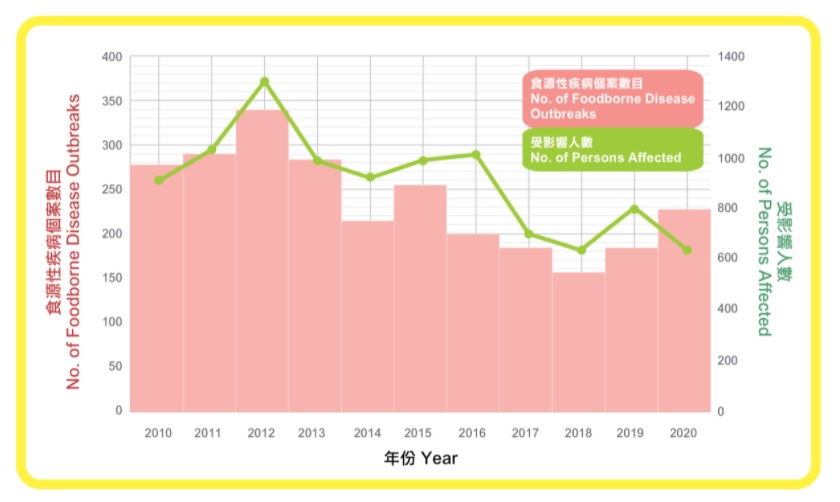
Figure 1: Number of FPOs related to food premises and the food business and the corresponding number of persons affected from 2010 to 2020
Causative Agents and Contributing Factors
Bacterial foodborne agents remained the leading causes (90%) of all FPOs in 2020, with Salmonella topping the list (76.3% of all bacterial cases), followed by Vibrio parahaemolyticus (VP) (16.9%) and Bacillus cereus (2.9%). Viral causes accounted for 7% of all FPOs in the year, and norovirus was virtually involved in all cases. The remaining FPOs were caused by natural toxins (such as mushroom toxins, ciguatera toxins) and chemicals (calcium oxalate), which accounted for 2.6% and 0.4% of the total FPOs respectively. Contamination by raw food, that by food handlers and improper holding temperature were the three most frequently identified factors contributing to the FPOs in 2020.
1) FPOs Related to Salmonella in Sandwiches
In May 2020, the CFS received 99 epidemiologically linked FPOs associated with the consumption of prepackaged sandwiches of the same brand, 236 persons were affected. The stool samples of 42 affected persons yielded Salmonella. One victim required intensive care and Salmonella enteritidis was detected in the blood specimen. Group D Salmonella was also found in one of the unconsumed sandwiches bought by a victim.
The sandwiches were produced by a local food factory. Field investigations showed that the outbreaks were caused by a number of factors, including contamination of ready-to-eat ingredients by raw ingredients and food handlers, improper holding temperature during transportation of the sandwiches to the retail outlets, and inappropriate storage temperature for the finished products (the products were left in the temperature danger zone, thus allowing pathogens to grow). In addition, the manufacturer did not provide the production date and expiry date on the packing of the sandwiches for the information of its staff and customers. A sandwich sample collected from a retail outlet was tested positive for Group D Salmonella.
As instructed by the CFS, the food factory and the retail outlets stopped the sale of all sandwiches immediately and proceeded with thorough cleansing and disinfection. The CFS also provided health advice for the food handlers and issued press releases to urge the public not to consume the incriminated sandwiches. Since then, the food factory operator has ceased the operation of the related food business.
Sandwich preparation often involves manual handling, and prepacked sandwiches produced by food factories are widely distributed to customers. Food factories should therefore adopt stringent food safety and hygiene practices to avoid contamination. As illustrated in this case, malpractices in any step of food production could lead to large-scale FPOs affecting a large number of people.
2) FPOs Related to VP in Takeaway Lobster Noodles
In September 2020, there were seven epidemiologically linked FPOs related to takeaway lobster noodles purchased from a restaurant, 19 persons were affected. The stool sample of a victim was tested with VP. Investigations revealed that the lobsters were cooked too far in advance to cater for the high demand during busy hours. As a result, they might have been contaminated by food handlers and other raw seafood. Apart from providing health advice on personal hygiene, food and environmental safety to the food premises concerned, the CFS also instructed them to suspend the sale of the incriminated food item immediately and carry out thorough cleansing and disinfection. No further related FPOs were received afterwards.
To prevent VP infection, it is important to cook food thoroughly, observe good hygiene practices and prevent cross-contamination of cooked food by raw seafood.
Conclusion
The large-scale sandwich-related FPOs in 2020 reminds the food trade that failure to adopt stringent food safety practices and lapses in personal and environmental hygiene can cause serious health hazards to the public. Takeaway foods have become more popular since the COVID-19 pandemic. The trade and the public should stay alert to the risks involved and adhere to the “Five Keys to Food Safety” to prevent occurrence of FPOs.
Mascot ON in Lesson
Food Safety Risks of Raw Oysters
Many people love to eat raw oysters for their rich seawater flavour. However, we should bear in mind that raw and partially cooked oysters are basically high-risk foods.
Oysters filter seawater for food. Harmful microorganisms, including viruses (e.g. norovirus and Hepatitis A virus) and bacteria (e.g. VP and Vibrio vulnificus), may accumulate in their tissues. These are foodborne pathogens that can cause symptoms like vomiting, nausea, diarrhea, headache and fever in humans. The consequence can be serious.
Oysters may also be contaminated by heavy metals like cadmium and lead. Acute toxicity resulting from consumption of such contaminated food is uncommon, but chronic exposure to heavy metals can have adverse health effects. The severity of toxic effects of heavy metals on humans varies according to the type of metals and the amounts taken. For example, cadmium is harmful to the kidney and lead is associated with neurodevelopmental disorders.
Health Advice from Mascot ON:
- Regardless of the season or the region in which the oysters are harvested, there is an inherent food safety risk consuming oysters, particularly raw or partially cooked ones.
- Susceptible populations (the elderly, young children, pregnant women and people with weakened immune systems) should avoid eating raw oysters.
- To reduce risks, we should patronise reliable and licensed shops for consumption or purchase of raw oysters.
- Never eat oysters in the raw state if they are intended for consumption after cooking. Such oysters must be fully cooked before consumption.
- Some tips for cooking oysters: boil for 3 to 5 minutes, fry for at least 3 minutes, or steam for 4 to 9 minutes.
Things to Note When Buying Hairy Crabs
Under the Food Business Regulation, save with the written permission of the Director of Food and Environmental Hygiene (DFEH), no person shall sell any restricted foods, including shell fish. The hairy crab is a kind of shell fish. In this connection, written permission must be obtained from the Food and Environmental Hygiene Department (FEHD) for the sale of hairy crabs. The FEHD has prepared a new permit for operators selling hairy crabs to apply. The permit requires that premises selling hairy crabs must comply with the relevant hygiene requirements, including the provision of a refrigerator and a wash-hand basin. Hairy crabs for sale must be obtained from lawful sources accompanied with health certificates acceptable to the DFEH and must be kept in a refrigerator to safeguard food safety. The licensee / permittee / person with written permission shall keep the health certificates and produce them for inspection upon demand by any health inspector. For online sale of hairy crabs, operators shall apply for a permit from the FEHD for selling restricted foods online. Consumers should buy hairy crabs from reliable shops or market stalls granted with the relevant food business licence / permit / written permission from the FEHD. When buying crabs, there are three don'ts to follow: don't buy dead crabs (choose those alive and fresh); don't consume raw (thorough cooking kills parasites and germs in the crabs); and don't overindulge (crabs are high in cholesterol and balanced diets are always ideal).
Please visit the following websites of FEHD for information about list of permitted premises concerned:
List of Permitted Premises for the Sale of Restricted Foods (Choose "Shell Fish (Hairy Crab) Permit" in "Permit Type")
https://www.fehd.gov.hk/english/licensing/licence-type-permit.html
List of Permitted Premises for Online Sale of Restricted Foods (Choose "Shell Fish (Hairy Crab)" in "Permit Type")
https://www.fehd.gov.hk/english/licensing/licence-online-permit.html
Dining Out
Excessive Coagulase-positive Staphylococci Organisms in Sample of Chicken Soup with Maitake Mushrooms and Figs
On 29 April 2021, the CFS announced a food complaint case which involved a restaurant in Lok Fu. As revealed by preliminary investigation, the incriminated food was suspected to be chicken soup with maitake mushrooms and figs. The sample taken from the restaurant was found to contain coagulase-positive staphylococci at a level of 16,000 organisms per gram. Under the Microbiological Guidelines for Food, ready-to-eat food that contains coagulase-positive staphylococci at a level of more than 10,000 organisms per gram is considered unsatisfactory.
Coagulase-positive Staphylococci Organisms
Coagulase-positive staphylococci organisms can produce enterotoxins that cause food poisoning. The common symptoms include nausea, vomiting and abdominal pain, often accompanied by diarrhea.
Advice to the Public
- Plan the cooking time ahead to avoid cooking the ingredients too soon.
- Use different clean utensils to handle raw, cooked and ready-to-eat food separately.
- When preparing or reheating soup, bring it to a boil and keep boiling for at least one minute.
- For cooling of cooked soup, reduce the temperature from 60℃ to 20℃ as soon as possible (within 2 hours) and further from 20℃ to 4℃ in no more than 2 hours (the whole cooling process should not exceed 4 hours).
- Keep cooked soup at 60℃ or above if it is not intended for immediate consumption.
- Maintain good personal hygiene practices and wash hands before eating.
Healthy Eating Basics and Smart Food Choices
Reading Nutrition Labels on Prepackaged Convenience Meals and Shopping Cards to Achieve a Healthy Diet
During the COVID-19 pandemic when social distancing is deemed necessary, prepackaged convenience meals provide an alternative dining option for consumers. While these processed foods are ready to be served through reheating, consumers may not be aware of the nutrition contents of the food products they have purchased and consumed, and may thus absorb more than the recommended amounts of total fat, salt or sugars.
Consumers can check the nutrient content of a food product by reading the nutrition label on the packaging. The CFS has designed shopping cards to inform consumers if a food product is high or low in total fat, salt or sugars. For example, a food product is considered high in total fat if it contains more than 20g of total fat per 100g of food. To achieve a balanced diet, consumers may compare the nutrition labels of food products and cross-check the information against the shopping cards before food purchase.

A Vegetarian Dish to Satisfy Your Appetite - Fried Rice with Diced Apples and Vegetables
We are used to eating fried rice prepared with meat, such as the Chinese-style fried rice. This time, we will bring you a variety in veggie style. The ingredients include diced apples, which are refreshing as well as naturally sweet in flavour. Therefore, we just need to add a small amount of seasonings to the fried rice. Apart from diced apple, we also put in diced carrots. Carrots contain carotene, which is good for improving our night vision and rich in dietary fibre. The dish is easy to make. The next time you feel hungry, you may give it a try.
Please visit the "EatSmart Restaurant Star+" website of the Department of Health (https://restaurant.eatsmart.gov.hk/eng/content.aspx?content_id=1090) for information about this dish and the recipe provided by KF Café & Restaurant.
News on CFS
Visit to CFS by Yuen Long District Councillor Representatives
The CFS strives to strengthen communication and collaboration with members of the public, the food trade and relevant stakeholders through different channels to enhance food safety in Hong Kong. On 30 April 2021, the Healthcare and Food Safety Committee (HFSC) of the Yuen Long District Council visited the Communication Resource Unit (CRU) of the CFS. The HFSC representatives paid a visit to the exhibition hall and had a discussion with the CFS staff on food safety matters in a harmonious manner.
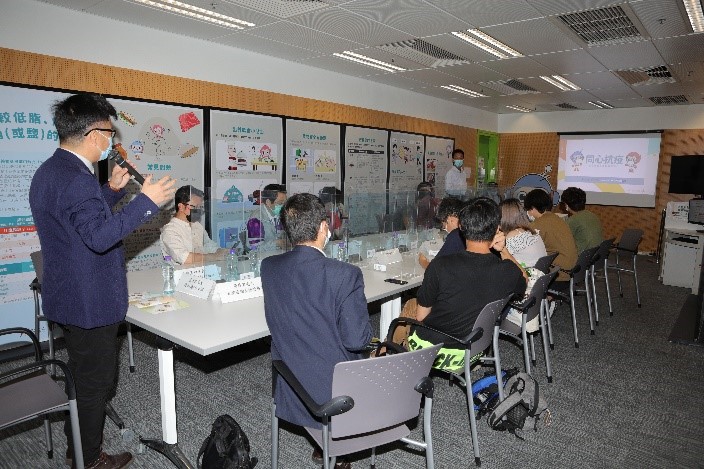
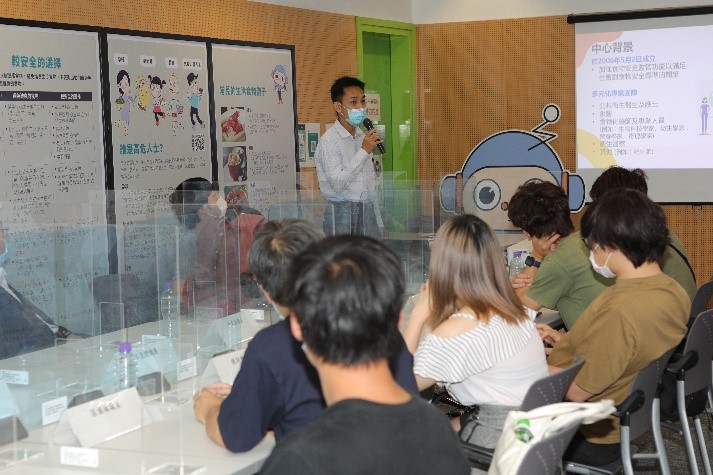
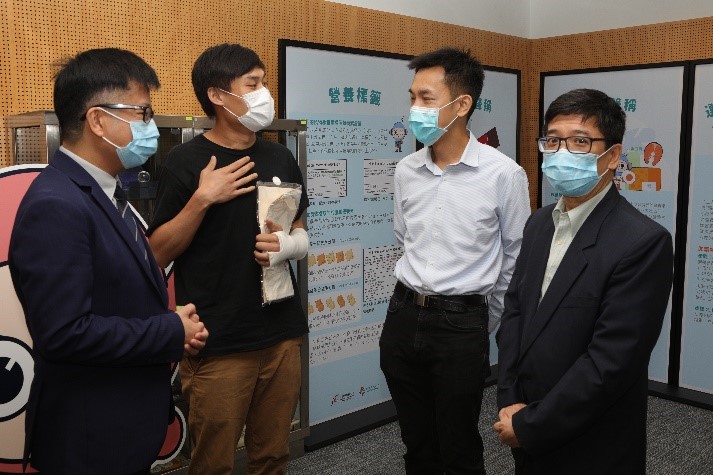
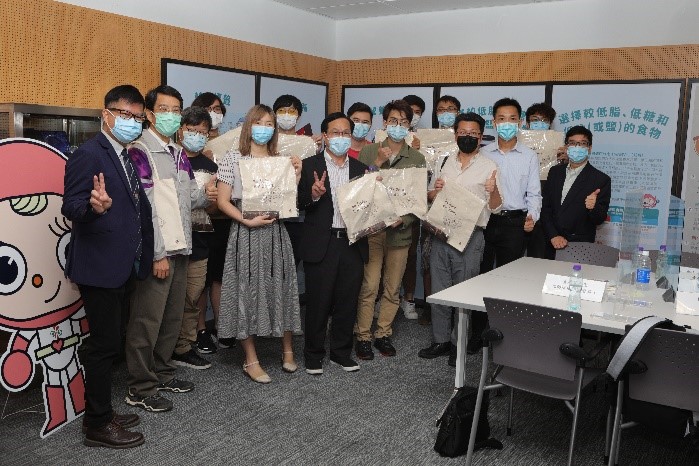
Visit to CFS by New Director of Food and Environmental Hygiene
On 16 June 2021, Ms Young Bick-kwan, Irene, the new Director of Food and Environmental Hygiene, visited different offices of the Food and Environmental Hygiene Department (FEHD) to gain a better understanding of the daily work of the Department. The tour included a visit to the CRU of the CFS in the company of Dr Tsui Lok-kin, Edwin, Controller of the CFS, Dr Ng Chi-cheung, Henry, Principal Medical Officer (Risk Assessment & Communication) and Dr Mang Chun-yu, Jerry, Senior Medical Officer (Risk Communication). That day, the CRU staff explained to the Director the work of the CRU on dissemination of food safety messages and guided her in visiting the exhibition hall, which was open to the public, and the emergency hotline centre which answered emergency enquiries in major food safety incidents.
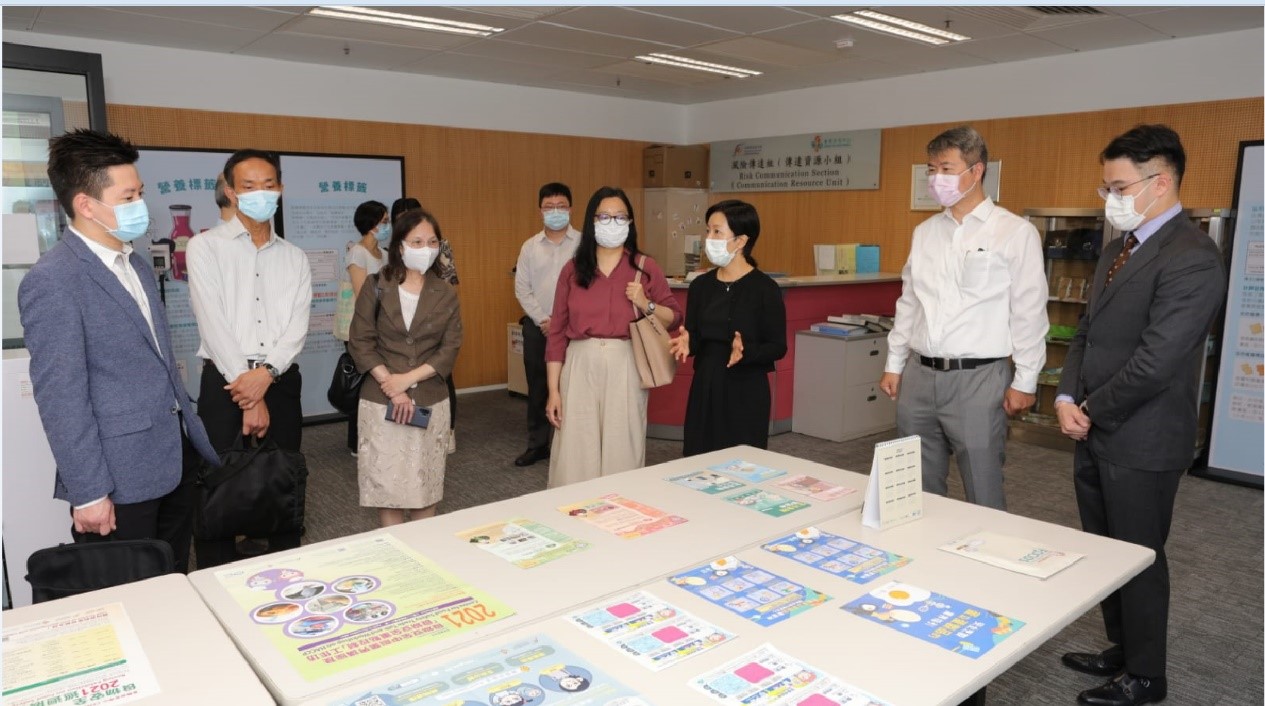
Release of Findings of Food Surveillance Programme
At a press conference held by the CFS on 20 July 2021, Dr TSUI Lok-kin, Edwin, Controller of the CFS, along with Dr LEUNG Ching-kan, Jackie, Assistant Director (Risk Management) and Dr YEUNG Tze-kiu, Samuel, Consultant (Community Medicine) (Risk Assessment and Communication), released the findings of the Summer Food Surveillance Programme 2021. According to the information, except for three samples (one of venus clam, one of clam and one of common oriental clam) detected with chloramphenicol (a veterinary drug), all other samples passed the microbiological tests and tests for metallic contaminants and veterinary drug residues. The overall satisfactory rate was 99.85%. Although no samples were found unsatisfactory in microbiological tests under the Programme, the CFS reminded the public to pay attention to food safety, especially in summer. They should observe the "Five Keys to Food Safety" to reduce the risk of food poisoning caused by bacteria and patronise licensed and hygienic restaurants when dining out.
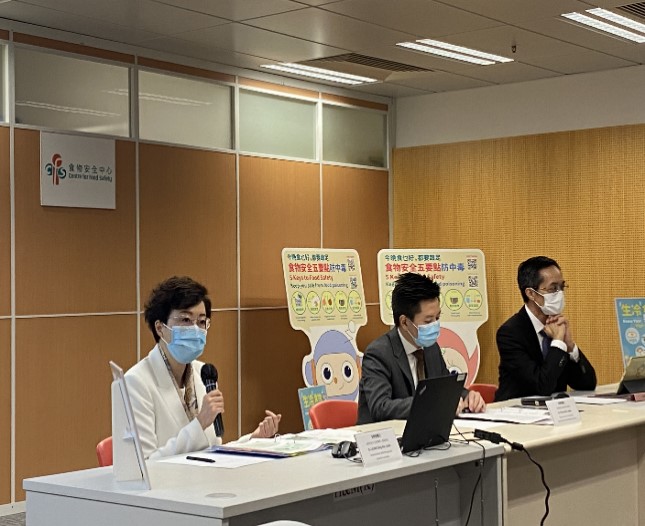
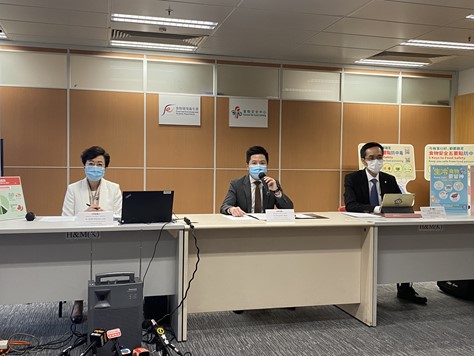
Ask Our Mascots
Suspected Food Poisoning Case Related to Consumption of Puffer Fish
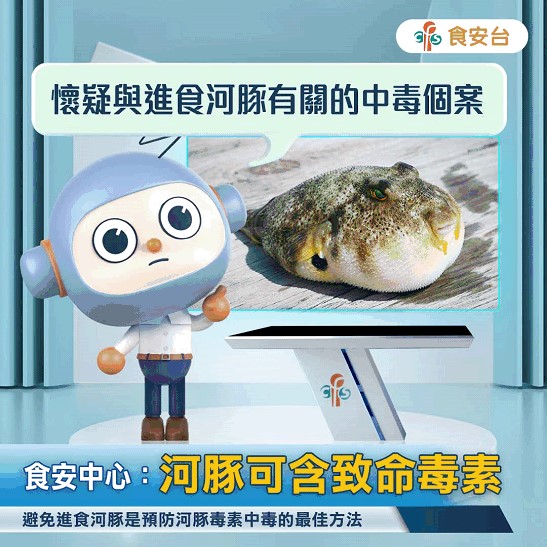
Mandy: Recently, there was a food poisoning case suspected to be caused by the consumption of puffer fish in a restaurant. What is puffer fish?
ON: Puffer fish is commonly known as globefish. It contains a potent toxin called tetrodotoxin, which is lethal to humans in a dose of around 1 to 2 mg. Tetrodotoxin is very heat-stable and is likely to remain in fish tissues even after a puffer fish is thoroughly cooked. Apart from puffer fish, other fish such as porcupine fish may also contain tetrodotoxin.
Mandy: According to what you say, it is really risky to eat puffer fish.
ON: Exactly. That’s why the CFS advises the public not to buy puffer fish and other unknown fish, or catch, dissect and clean them on their own. They should also avoid eating these fish. As for the trade, traders should take note that the law in Hong Kong requires that all food for sale in the market must be fit for human consumption. They should ensure that fish and fish products imported for sale in Hong Kong are safe for consumption by consumers.
Food Safety Quiz
-
In which year was the CFS established?
a. 2000
b. 2006
c. 2018
-
What is the point to note in consuming raw oysters?
a. Follow food reviews to partronise whatever shops we like for purchase/consumption of raw oysters.
b. It is alright to eat a lot of raw oysters at a time as they are delicious.
c. Raw oysters must be cooked thoroughly before consumption.
-
Which of the following statements about tetrodotoxin (TTX) is correct?
a. TTX is very heat-stable and is likely to remain in fish tissues even after a puffer fish is thoroughly cooked.
b. TTX is only found in puffer fish.
c. TTX is not a powerful toxin. Humans will not die because of exposure to TTX.Answers:
Answers:
1) b 2) c 3) a
Diary of Mascot ON
15th Anniversary of CFS
#MUI: ON, let me give you a quiz. Do you know how long the CFS has been established?
#ON: That's easy. This year marks the 15th anniversary of the CFS. Let me tell you its history.
The CFS was established under the FEHD on 2 May 2006 with a view to enhancing food safety control and meeting public expectations for better food safety standards. It adopts the science-based risk analysis approach promulgated by international food safety authorities to strengthen food safety control in various stages of the food chain. Stepping into its 15th anniversary, the CFS has introduced a new video in the year featuring its work on the food safety front. Please click the following link or scan the QR code on the right to watch the video for more information about the CFS:
https://www.cfs.gov.hk/english/aboutus/aboutus_iv/aboutus_iv.html
